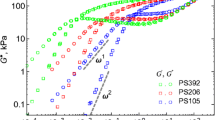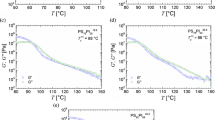Summary
The dynamic viscoelastic behavior of polystyrenes, with molecular weights above the critical molecular weight (M w ranging from 37.000 to 670.000), has been studied in a broad range of frequencies (10−5 to 103s−1, using time-temperature superposition principle).
Three different approaches for the analysis of the dynamic properties have been used in order to show the interest and the limits of each other (complex shear modulusG * (ω), complex viscosityη * (ω), and complex complianceJ * (ω)). A new analysis of the complex compliance shows that it can be fitted by the equation:
This equation is satisfactory in order to represent the viscoelastic properties of narrow MWD polymers above the critical molecular weight (the termJ *p (ω) disappearing forM < M c).
Theη 0 andτ p parameters depend on chain length following the same law (∝M 3,4w ).
TheJ t,τ t andβ parameters, characteristic of the transition zone, are independent ofM w.
J p andα are independent of chain length for narrow MWD samples; however these values are quite sensitive on a light broadening of the MWD.
Résumé
Le comportement viscoélastique en régime dynamique de polystyrènes de masses égale et supérieures à la masse critique (M w variant de 37.000 à 670.000) a été étudié dans un très large domaine de fréquences (10−5 à 103 Hz environ, en utilisant le principe de superposition temps-température). Trois approches différentes de l'analyse des propriétés dynamiques ont été abordées, afin de montrer l'intérêt et les limites de chacune d'entre elles (module de cisaillement complexeG * (ω), viscosité complexeη * (ω) et complaisance complexeJ * (ω). Une approche originale de l'étude de la complaisance complexe permet de proposer une expression analytique de celle-ci:
qui s'avère satisfaisante pour représenter les propriétés viscoélastiques de polymères à distribution très étroite de masses moléculaires au-dessus de la masse critique (le termeJ *p (ω) disparaissant pourM ≤ M c).
-
—Les paramètresη 0 etτ p varient de façon identique en fonction de la longueur des chaînes (∝M 3,4w ).
-
—Les paramètresJ t,τ t etβ caractéristiques de la zone de transition, sont indépendants de la masse moléculaire.
-
—Les paramètresJ p,α sont indépendants de la longueur des chaînes pour des échantillons à distribution très étroite, quoique leurs valeurs soient très sensibles à un élargissement, même minime, de la distribution des masses moléculaires.
Similar content being viewed by others
References
Macosko, C. W., W. M. Davis Rheol. Acta13, 814 (1974).
Ferry, J. D. Viscoelastic properties of polymers (J. Wiley and Sons, New York 1970).
Onogi, S., T. Masuda, K. Kitagawa Macromolecules2, 109 (1970).
Graessley, W. W., The entanglement concept in rheology, Advances in Polymer Science, 16 (1974).
Marin, G., J. J. Labaig, Ph. Monge Polymer16, 223 (1975).
Marin, G., Thèse, Université de Pau, 1975.
Riande, E., M. Markovitz, J. D. Plazek, N. Raghupathi J. Polymer Sci., Symposium50, 405 (1975).
Lamb, J. Rheol. Acta12, 438 (1973).
Harrison, G. The dynamic properties of supercooled liquids (Academic Press, London 1976).
Gross, B. Mathematical structure of the theories of viscoelasticity (Hermann et Cie, Paris 1953).
Author information
Authors and Affiliations
Additional information
With 8 figures and 2 tables
Rights and permissions
About this article
Cite this article
Marin, G., Graessley, W.W. Viscoelastic properties of high molecular weight polymers in the molten state. Rheol Acta 16, 527–533 (1977). https://doi.org/10.1007/BF01525652
Received:
Issue Date:
DOI: https://doi.org/10.1007/BF01525652




